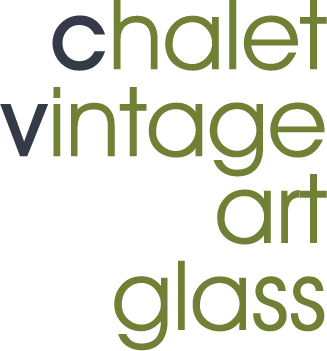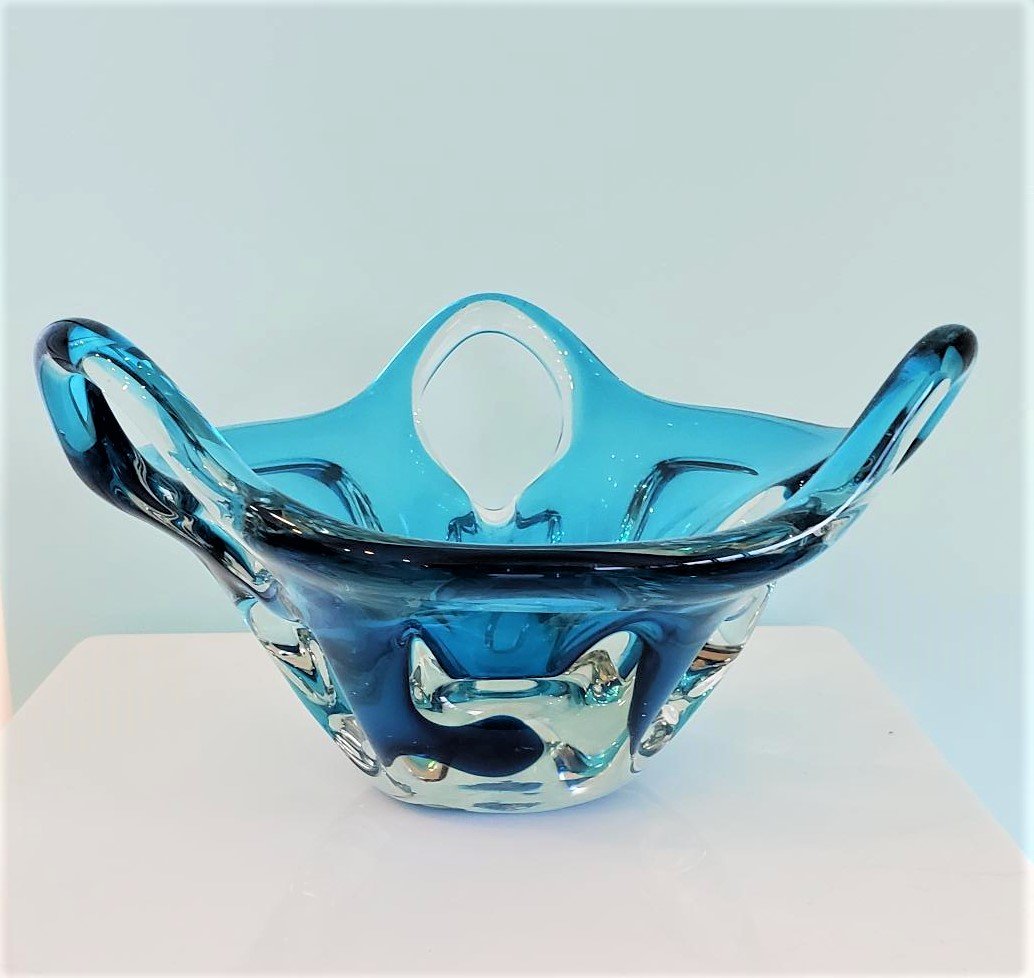Chalet corporate advertising and marketing
Chalet’s company marketing and advertising strategies remained consistent throughout its entire history. Their plan was self-directed and went hand-in-hand with their creative philosophy of originality. From the onset, they branded themselves in two distinct ways – as Canadian and as makers of quality, artist created products. Their goal was to elevate Chalet to Canada’s premier art glass company.
The name change from Murano Glass to Chalet Artistic Glass was the first step. We have heard directly from the artists that Angelo Tedesco himself decided that the word “chalet” sounded Canadian and that is the reason it was chosen. The adoption of a “Canadian” style of glass was the next. In the words of Angelo Tedesco, “We had to change Venetian design to a small, modern design. Less artistic but more useful. Artistic for Canadian homes.” From “Why Canada,” 1965.
Over and over and over again, both the visuals and wording in the company branding stressed that Chalet glass was “ … artistic, original, hand-made, mouth-blown, hand-formed, and hand-crafted.” Their iconic etched signature reflects this (as well as reinforcing the Canadian connectio) with its elegant script and an image of a canna as the cross bar on the letter “t”.
The image of a glass blower with a canna were also used on both the large and small stickers seen on much of the Chalet product distributed by Montreal-based Chantili. This image was appropriated by Rossi Glass (2nd photo directly below) in later years after Chalet’s closure. EDAG also marketed their glass as a quality product. The words “Hand Made crystal” and a glass blower with a canna were on their company sticker. Note that the canna in the EDAG branding (3rd photograph following) is pointing up while the canna in the Chalet Chantili sticker is pointing down.
This Chalet hang tag from the “Canadiana Cranberry Glass” line is another example of Chalet’s marketing focus. It doesn’t miss a beat - this one branding stressing that these were quality products (seven references) crafted by Canadian (mentioned four times) artists.
Chalet glass was also stickered with labels in the shape of an artist’s palette on lines carried by the company’s largest distributers in Canada (N.C. Cameron and Sons) and in the United States (Riekes Crisa). And later, Chalet increased the lead content of their pieces so that their glass could be marketed as “lead crystal” even though art glass is not typically described as “lead crystal.” This was done so that Riekes Crisa, an American giant in the distribution of home décor, would carry their products. Chalet made much of this with special press releases, product launches and branding reflected this as well.
March 1972 Chalet company press release. Courtesy of Mario Panizzon.
No coincidence that this photograph used in the Cornwall Standard-Freeholder September 17, 1962 article “As the Camera sees It” fits right in with Chalet’s marketing.
Laura Fuga, wife of Chalet artist Carlo Fuga, worked at the Chalet factory – giving tours and packing glass. From the archives of the Cornwall Community Museum.
Company stationary and many of their press releases depicted the tools used in mouth blowing and hand creating glass.
Chalet’s 1967 Centennial press release/announcement. Courtesy of Mario Panizzon.
We often hear the term “truth in advertising.” What does this mean and does it apply to Chalet? In Canada, truth in advertising is regulated by the federal Competition Act of 1985. It charges that “It is against the law to make any false or misleading representation to the public for the purpose of promoting a business interest, particularly if it is done deliberately or recklessly.” Given the time frame (Chalet closed in 1975), it serves us better to examine their advertising through another lens. That of “learning and verification through advertising.”
The following Chalet company advertisements run in the Cornwall Standard-Freeholder are not only proof positive regarding many facts and theories but they also give us a great deal of information. Let’s analyze:
Advertisements courtesy of Don Smith, Cornwall Community Museum.
This one-of-a-kind piece was likely sold right at the factory as above:
A Chalet inventory label was used as a pricing sticker.
The most obvious evidence that these provide is without a doubt verification of direct sales from the factory to the public. Not only were these ads placed by the Chalet management, but the sale’s actual physical address (the Chalet factory location) shows that purchasing was indeed possible right at the factory. This was a logical assumption, now a fact, that we had made earlier based on the historical photographs of Chalet factory tour signs and of visitors watching the artists at work. We also had been told by the artists that these tours brought in a lot of buying traffic and that special order pieces were requested right from the factory.
Tourist centre.
Photographs courtesy of the Cornwall Community Museum.
Chalet artist Antonio Tedesco with his niece (Fiorella Pagnin) and nephew (Francesco Pagnin) in an area of the Chalet showroom. Photograph courtesy of Antonio Tedesco.
Angelo Tedesco being interviewed in the showroom of the Chalet Artistic Glass factory during the 1971, filming of the National Film board’s documentary “Here is Canada.” The showroom was not an elaborately set-up display area. It was pretty “bare bones.”
We also learned from the Chalet artists that up to 25% of the 700-800 production pieces made daily would be determined by the teams’ Maestri to be “Not good glass.” It seemed incomprehensible that these pieces would just be “dumped.” The artists said that these were either repaired or sold “as is” and branded as seconds right from the factory. All four of these ads confirm that pieces were consistently graded and that those deemed “seconds” were marketed as such. We do not have the exact details on how they were presented or if branded separately but these ads corroborate that seconds were not discarded and actually provided ongoing and consistent revenue for Chalet.
I purchased this rare Chalet “6 arm stretch” at the Morrisburg flea market very close to Cornwall. The seller had to point out the flaw as it was so expertly repaired that I had totally missed it. I showed it to the artists and they confirmed that it had been professionally repaired but could not say if it was a Chalet marketed “second.”
These ads are also significant for giving us a small tidbit more regarding Chalet’s stemware and tableware lines. Few collectors are aware that Chalet was affiliated with an “associate glass-making company” - Monogram Glass Company of Canada. The two companies used different glass blowers and did not share the exact physical factory floor but were located in the same building and pooled other resources. The affiliate did not stay in business up until 1975 (I do not have exact date when these lines were discontinued) as Canadians were not as ready to pay high prices for stemware and tableware as they were for home décor items. However, advertising does give us some sort of operational time frame as the sale of stemware is advertised up until 1970. company ceased.
September 17, 1962. From the Cornwall Standard Freeholder, a division of Postmedia network Inc. From the archives of the Cornwall Community Museum.
What else does the advertising above show or prove? Several more things. Firstly, it further establishes that though Chalet was a factory, they did certainly produce some non-production pieces. Unique one- of- a-kind pieces. Rarer pieces that were produced in low numbers. Pieces that we know were prototypes for new forms and lines, samples for distributors, “piccoli” minis done at the end of the day … And in enough quantity that they could be offered as part of featured inventory in a special occasion sale.
“Never say Never” pieces. The vases shown here are two good examples of non-production pieces that could have been sold from the factory and I am lucky enough to have them in my personal collection
Both vases are etched with the “Chalet Canada” signature.
Next, the sale also mentions “End of Line” and “Discontinued Lines.” Unfortunately, we have little concrete information to which pieces this is pertaining. Were these individual pieces that were poor sellers? Entire lines that proved unsaleable? Some selections from the early ‘Items Available” brochure are seen in exceedingly low numbers so it is obvious that they did not go forward as ongoing production pieces. This A40 “forato” (pierced) piece is an excellent illustration of this point.
Etched “Chalet Canada” and again, from my personal collection.
And the iconic Chalet basket is just one excellent illustration of an evolution of form. Perhaps older “models” were held back for factory sale when newer versions of the form were put into production.
1962 BB1. Photograph courtesy of 50 member Daniel Lynch.
Later version of BB1.
Here is another company press release. Chalet did not limit their local or national advertising to newspaper sale solicitations. They also ran corporate marketing campaigns emphasizing Chalet’s position as an important employer and Cornwall attraction.
Courtesy of Don Smith, Cornwall Community Museum.
These were bolstered by ongoing independent newspaper coverage.
Article from January 17, 1964, Ottawa Citizen, a division of Postmedia Network, Inc. Glassblower is Chalet owner Maestro Luigi Tedesco. He was 26 years old at this time. Woman with the glass is Patricia O’Connell. When I spoke with Ms. O’Connell about her connection to the glass she told me, ‘I was just a pretty girl at a party.” A photographer, also a guest, asked her if she would be interested in making some extra money doing a quick newspaper photo shoot. She had never seen Chalet glass before and none of the owners attended the photography session.
The piece showcased in the article with her is BB41. Featured in the 1962 Chalet Artistic Glass ‘Items Available” sales brochure.
This early BB41 basket is from the collection of 50 Shades member Daniel Lynch.
To summarize, the Chalet company marketing and advertising, including branding and press releases, that we have uncovered (some of which is shown above) proves that Chalet actively participated in promoting and distributing their product, growing their market-share, and establishing themselves as Canada’s premier art glass company. They were not passive bystanders to the company’s success and this holds true to what we were told by the artists, “Angelo was all about the business. Sergio and Luigi were all about the glass.”
On a humerous note, here’s a look at what can happen with even “the best laid marketing and advertising plans”:
Ad on left is from “The Gazette” (Montreal) which is a division of Postmedia Network Inc. Ad on right is from the Ottawa Journal.
































